Survey Response Rates to a Self-Initiated Longitudinal Survey Accessed by a Quick Response Code in Six Different Regions of the United States
- PMID: 35747044
- PMCID: PMC9206521
- DOI: 10.7759/cureus.25146
Survey Response Rates to a Self-Initiated Longitudinal Survey Accessed by a Quick Response Code in Six Different Regions of the United States
Abstract
Background A quick response (QR) code allows rapid access to an online survey via a smartphone and may improve response rates for web-based surveys. We report the response rates for a QR code-based, self-initiated, longitudinal survey of opioid use and pain scores following hospital discharge in pediatric surgical patients. Methodology All parents of pediatric patients who underwent surgery at one of six pediatric medical facilities were asked to participate in the study from October 5, 2020, until July 15, 2021. Those who chose to participate accessed the initial enrollment survey using a QR code on a handout provided. The next day they received an emailed link to a daily survey until their child was not requiring opioids and had pain scores of less than 4 for the previous 48 hours. Results A total of 1,759 families were asked to participate in the study. The parents of 44 patients completed the initial enrollment survey by accessing the QR code (response rate of 2.5%). Of those who completed the initial survey, 67% were lost to follow-up during the survey series. Conclusions We found an extremely low response rate for a self-initiated survey accessed by QR code. Additionally, we found a drop in the response rate with each successive daily email-based survey. At the end of the survey series, the majority of the initial participants had dropped out. We recommend using alternative modalities (informed consent, telephone call, weekly surveys) for initiating and delivering surveys to improve response rates for similarly designed studies.
Keywords: orthopedics; pediatrics; qr code; response rates; survey response.
Copyright © 2022, Halpern et al.
Conflict of interest statement
The authors have declared that no competing interests exist.
Figures
Similar articles
-
A novel use of QR code stickers after orthopaedic cast application.Ann R Coll Surg Engl. 2017 Jul;99(6):476-478. doi: 10.1308/rcsann.2017.0070. Ann R Coll Surg Engl. 2017. PMID: 28660817 Free PMC article.
-
The efficiency of quick response code versus telephone contact for post-discharge follow-up after ophthalmic day surgery: a randomized controlled trial.Int Ophthalmol. 2023 Aug;43(8):2669-2677. doi: 10.1007/s10792-023-02666-6. Epub 2023 Mar 9. Int Ophthalmol. 2023. PMID: 36894822 Free PMC article. Clinical Trial.
-
Tablet Versus Quick Response Code: Difference in Research Participation Rates?J Technol Behav Sci. 2023;8(2):178-181. doi: 10.1007/s41347-023-00311-8. Epub 2023 Mar 3. J Technol Behav Sci. 2023. PMID: 37215394 Free PMC article.
-
Evaluation and implementation of QR Code Identity Tag system for Healthcare in Turkey.Springerplus. 2016 Aug 30;5(1):1454. doi: 10.1186/s40064-016-3020-9. eCollection 2016. Springerplus. 2016. PMID: 27652030 Free PMC article.
-
Quick response code applications in medical and cardiology settings: a systematic scoping review.Eur Heart J Digit Health. 2021 Apr 8;2(2):336-341. doi: 10.1093/ehjdh/ztab038. eCollection 2021 Jun. Eur Heart J Digit Health. 2021. PMID: 37155668 Free PMC article.
Cited by
-
Long-Term Socioeconomic and Neurologic Outcome for Individuals with Childhood-Onset Multiple Sclerosis.Children (Basel). 2024 Aug 21;11(8):1024. doi: 10.3390/children11081024. Children (Basel). 2024. PMID: 39201957 Free PMC article.
References
-
- Factors affecting response rates in medical imaging survey studies. Zha N, Alabousi M, Katz DS, Su J, Patlas M. Acad Radiol. 2020;27:421–427. - PubMed
LinkOut - more resources
Full Text Sources
Miscellaneous



